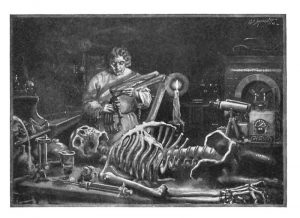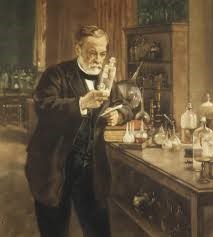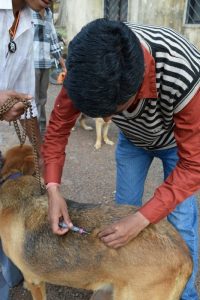Biology behind Frankenstein

Fig. 1, Victor Frankenstein creating his monster. “File:Frankenstein, pg 7.jpg.” Wikimedia Commons, the free media repository. 1 May 2019, 20:17 UTC. 27 Oct 2019, 04:31 <https://commons.wikimedia.org/w/index.php?title=File:Frankenstein,_pg_7.jpg&oldid=348246346>.
What is Frankenstein?
Mary Shelley’s science fiction horror, Frankenstein, is deemed to be the very first science-fiction novel and has stood as a foundation for many other scientific horrors over the past two centuries. This classic piece of English literature explores the both beauty and danger of knowledge, the social morality that encompasses the progression of technology and the excitement and fear that is induced by the power of science. (Harkup) And seeing that it was written during a period of vast scientific discoveries, this book delves deep into the frightening possibilities that new science brought to the public’s eye, jarring the reader’s even more at the bone chilling prospects of monster building and re animation.
The book begins as a series of letters from a captain of a North Pole bound ship, Robert Walton, as he writes to his sister. In these letters, Walton starts to recount the strange happening that occurred as he and his shipmates were trapped in ice; while waiting for the icy to melt and free them, a lone stranger traveling atop the ice on a dog sledge was spotted and brought on board in a state of extreme exhaustion. The stranger was no other than the young Victor Frankenstein and, after being nursed back to consciousness, he explains to Walton he is chasing his enemy, a monster of his own creation. The story then switches to Victor’s tale and how he came to be in this predicament.
As a young boy, Victor was incredibly gifted and was highly motivated by curiosity, especially towards science. When he became of-age, he entered an elite institute where he studied natural philosophy and chemistry. As he further indulges his naïve hunger for discovery and knowledge, the situation begins to get intense. On this path to extended knowledge, he is consumed by his work and begins to build together a creature from grave-snatched body parts. Harnessing the energy from electricity, he is able to re-animate the corpse and bring to life his creation, only to be absolutely horrified of what he has done. As the story continues, Victor faces the stages of depression, denial and anxiety of what his toying has caused, all while having to deal with the destruction his monster creates. Ultimately, Victors neglect towards his creation gets many of his loved ones killed and his very quest for revenge results in his death.
Integration of Biology
Although Frankenstein involves many reoccurring allusions to scientific advancements and themes, the two most prominent reoccurring themes are that of electricity and the process of creating life. When writing the book, Mary Shelley was very inspired by actual scientific advancements of her day. Towards the beginning of the 18th-century, science in today’s definition of the study (more commonly known then as natural philosophy) was still a very new and unexplored realm. (Harkup) Medieval views sought to explain the world as revelations of God, but as the Enlightenment Era dawned, new inventions began to spring up and with them came scientific progress and newly realized views of the world. Electricity and the means to harness it were discovered and, as the world continued to be shocked and appalled at it’s abilities, new questions arose about the true capabilities to all that raw power. (Harkup) Experiments were conducted to explore its effects on living and dead material and popular scientists, such as physicist Giovanni Aldini, made attempts to raise the dead through applying electrical currents. (Semiatin) Although the book never clearly states the methods Victor uses to animate his creature, many interpretations point to electricity, for this was one of the biggest scientific puzzles of Shelley’s time.
Along with the implications of electric technology, anatomy is a major themes, as well as how Victor creates something new from previously dead material.
“Pursuing these reflections, I thought that if I could bestow animation upon lifeless matter, I might in process of time (although I now found it impossible) renew life where death had apparently devoted the body to corruption. “ (Shelley)
He must go through the tedious process of accurately recreating a full human from dismembered parts, testing his skills and knowledge on the human form and all the complexities it holds.
Believability of the Biology
We know today that corpses cannot be brought back to life through any means, especially not with lightening or electrical currents. We know now that our bodily movements are results of internal electrical currents and stimulus that cause our muscles to convulse and contract to move things. Any movement that occurs when electrical pulses are applied to dead material are just involuntary contractions of muscles and are by no means considered “bringing it to life.” So, by today’s standards, this application of scientific and biological justification would not be believable.
That being said, the standards of the time were completely different. To the knowledge of people in the 18th century, this could have very well been something achievable and when new sciences are being regularly discovered, a story of this kind could be very believable.
How it relates to class
Another one of Shelley’s inspirations for the novel was the observations of “spontaneous generation” like that of Aristotle and the science behind debunking it. In a preface in the 1831 edition of the book, she “recalled an experiment in spontaneous generation–a piece of ordinary vermicelli preserved under a glass case seemed to move and show signs of life.” (Harkup) This is a concept that we have briefly explored in class and something that we know has been disproven by scientists like Francesco Redi and Louis Pasteur.
Work Cited
Harkup, Kathryn. “The Science Behind the Fiction: Frankenstein in historical context.” Natural History, Apr. 2018, p. 34+. Gale Academic Onefile, https://link-gale-com.lcc.idm.oclc.org/apps/doc/A536255858/AONE?u=lom_lansingcc&sid=AONE&xid=e2ea41b4. Accessed 27 Oct. 2019.
Semiatin, Steve. “Giovanni Aldini: Bringing the Dead to Life; Steve Semiatin Examines the Experiments of the Man Who made Corpses Come to Life.” History Magazine, vol. 12, no. 5, 2011, pp. 52.
Shelley, Mary. Stewart, Diana, et al. Frankenstein. Raintree Publishers, 1981.


